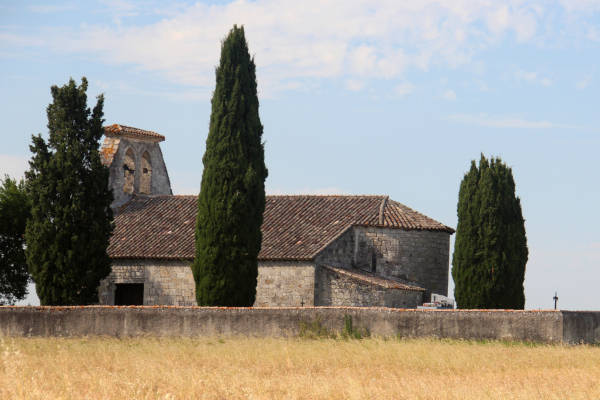This charming chapel was founded by Hunaud de Gavarret, the second Cluniac abbot of Moissac. It was subsequently given to the Saint-Maurin abbey. The illustrious patronage of Moissac could explain the decoration in this otherwise modest chapel, above all its sculpted capitals.
It is one of St Maurin abbey’s oldest possessions.
Its distinctive feature is a modillon which has been re-used above the doorway. Despite the ravages of time, its finesses of line and expression remain.
Come and immerse yourself in the 3D virtual visit of the church. An unforgettable experience! Launch the visit by clicking on the video Matterport.
The creation of this virtual tour was 100% financed by the Lot-et-Garonne 2022 Citizen’s Participatory Budget.
The architecture
The 11th century architectural elements which have survived are the chevet and part of the north wall of the nave. In the 17th century the Bélarcher de Serène family partially destroyed the south wall in order to construct the chapel of Saint-Clair.
Like other rural chapels, Saint-Julien has preserved vestiges of the Romanesque. This is because the Hundred Years’ War and the Wars of Religion, as well as the Revolution, barely touched rural churches. They have been altered rather than rebuilt, like Saint-Julien in the 17th century.
The apse has preserved a pretty cornice of three rows of square billets, which supported the former semi-dome (cul-de-four); the cornice continued, decorated with tracery and rosettes under a dome which no longer exists.

The capitals
We can however still see the four engaged columns with capitals that provide the key interest of this church, and demonstrate the importance accorded to decoration, buttress of the faith. People and monsters are carved in the body of the capitals, also double-bodied animals with a single head joined at the corners; topped by foliage, palmettes, tracery and vine tendrils.


The fourth capital, today in the nave deprived of its topping slab, is naively carved, but its subject is important, as it illustrantes the faith of Daniel in the lion’s den.
In the centre, the prophet faces us in an attitude of prayer, hands open, framed by two lions who are turned towards him without animosity. If Daniel’s hands appear huge and disproportionate, this is not an error by the sculptor, but his wish to highlight the strength of Daniel’s prayer.

